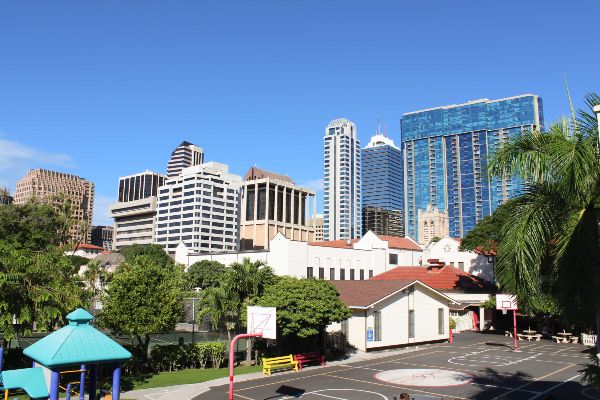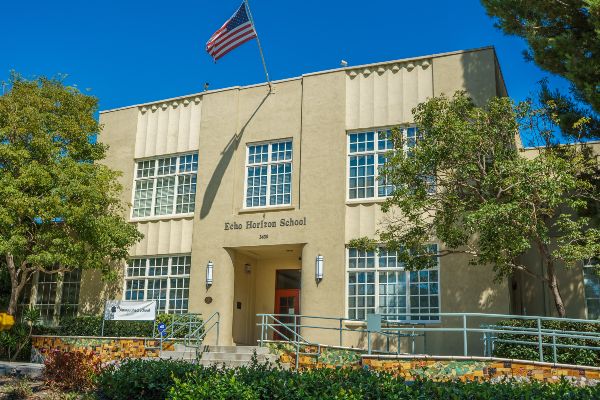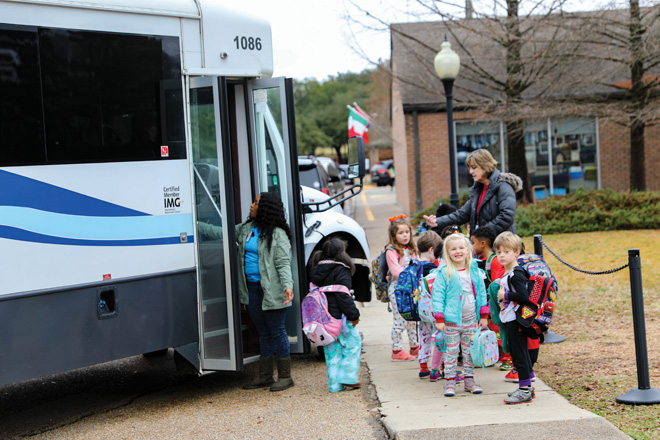Article by Leah Thayer
Feature image: A chartered bus service brings several dozens of students from another school to the after-school program at St. Andrew's Episcopal School in Jackson, Mississippi.
Business officers face increasing pressure to supplement tuition income with new revenue sources, but these efforts often come at a cost. From the staffing, scheduling and wear-and-tear of auxiliary programs to the overhead and uncertainty associated with annual giving and fundraising, some efforts lose more money than they make in the long run, if not also sapping morale and undermining the school’s greater mission.
In some cases, however, a new revenue stream (or a significant source of savings) requires little additional effort or investment on the part of a school. It’s just waiting to be tapped. “With continued pressure on schools to keep their tuition at affordable levels, business officers are becoming increasingly creative at ways to generate nontuition revenue for their schools,” said Jeff Shields, NBOA’s president and CEO. “It’s not just about after-school programs and summer camps.”
Here are five examples.
St. Andrew’s Schools, Honolulu
Facilities/campus rentals: roughly $200,000 annually
Last August, Hurricane Lane built to a Category 5 storm and appeared headed for Hawaii. Anticipating damaging winds and flooding, Hawaii residents stocked up on necessities, secured their homes and studied evacuation routes. At the downtown campus of St. Andrew’s Schools, CFO Mike Curtis was overseeing preparation on a large scale. Under an agreement with nearby Hawaii Pacific University, the school’s gymnasium would serve as an emergency evacuation site for HPU students who live in waterfront dorms. The university pays St. Andrew’s an annual “option fee” to keep this contingency open. It will pay a potential activation fee plus a day rate in the event of actual use.
As nature had it, Lane switched course at the 11th hour, sparing the island a direct hit. The college students never moved into St. Andrew’s gym. But the school, founded in 1867 by Queen Emma and now comprising two single-gender K-12 schools and a preschool, stands ready for the next potential evacuation. Plus, it has several other sources of rental income — to the tune of some $200,000 a year, according to Curtis. “That’s not insignificant for us,” he said, noting the school’s operating budget of approximately $9 million. “It represents the kind of entrepreneurial thinking that our schools need to do more of.”

There are short-term rentals, for instance — fundraisers, sports clinics, the occasional location shoot for — what else? —Hawaii Five-O. More notable, however, are long-term rentals. For instance, HPU’s women’s volleyball team rents the gym for practices and games. A church rents an underused chapel. A drill team rents the dance studio. A nonprofit youth-justice organization rents office space. Another office is occupied by a student-exchange program that brings international students to the mainland U.S. and Hawaii, including at St. Andrew’s. That organization doesn’t pay rent, but it provides the school with students at a negotiated rate based on revenue targets.
Several factors make facilities rentals work for St. Andrew’s, Curtis said. “Our core downtown location is important to our rental demand,” he admitted, but equally important — especially for long-term rentals — is finding mission-aligned tenants who are passionate about their work and respect the school’s values. Two of the tenant organizations are run by former St. Andrew’s teachers, for example. Mutual reciprocity governs the broader relationship with HPU, such as St. Andrew’s faculty and staff getting a major tuition cut on HPU classes, and HPU education majors interning at St. Andrew’s. And the youth-justice organization, which helps minor victims of sexual assault build cases against their perpetrators, provides a home-like setting above the preschool. “The kids feel comfortable coming here,” said Curtis. The organization’s staff benefit from the happy setting too. “One of the amazing things I heard was that when they need respite, they go out on the lanai and watch the preschoolers play. They feel better.”
St. Andrew’s Episcopal School, Jackson, Mississippi
After-school for non-enrolled students: roughly $100,000 annually
At another St. Andrew’s, it’s an aspect of the school’s program, rather than its campus, that produces supplemental nontuition revenue. Every day, a popular after-school program at St. Andrew’s Episcopal School brings in some 52 students who are enrolled at other schools. Most come from a public Montessori school near the lower-school campus of the preK-12 school, which has 1,140 students in all. “It’s been successful on many levels,” said Kevin Lewis, associate head of school and CFO. “It’s certainly mission-appropriate, and our students get exposure to other students they don’t normally see over the course of the day.” Additional operating costs have been minimal, as the visiting students are dispersed among several age groups and do not require more staffing. And the bottom line has been robust. “We charge them a little more than our students pay, and they’re bringing in about $100,000 a year,” he said. A few after-school visitors have even gone on to enroll full-time at St. Andrew’s.
Additional operating costs have been minimal, as the visiting students are dispersed among several age groups and do not require more staffing. And the bottom line has been robust.
Lewis credits Jay Losset, St. Andrew’s director of auxiliary programs, for much of this success. “Jay is very entrepreneurial, always thinking about ways to grow his programming.” After School Care (ASC) includes several levels of caregiving, supervision and enrichment classes, and the school even provides chartered bus service for one-way transportation from the other school.
The ASC program is just one way St. Andrew’s showcases its assets to the broader community. A new, 65,000-square-foot athletic facility hosts major sports tournaments and the annual meeting of the Junior League of Jackson. Another organization rents the facilities to teach local families about Japanese language and culture — popular topics, thanks to the Nissan North America plant 20 miles away.
Echo Horizon School, Culver City, California
One-time real estate investment: $220,000 return
The year 2015 brought some pivotal decisions to Echo Horizon School, a preK-6 institution with under 200 students at the time. Following a steady decline in enrollment and tuition revenue, “we made the strategic decision to go small” after the academic year, said CFO Saundra Sparks. This entailed restructuring from two classes per grade to one, and eliminating assistant teachers and aides “just to gain enough runway to turn the ship around. It was brutally painful,” she recalled.

However, the school also had a means to avoid further cuts — Los Angeles’s rapidly appreciating real estate market. Echo Horizon doesn’t own its building; it leases the space from the Culver City Unified School District. Opportunity knocked in late 2013 when the owner of a modest duplex down the block decided to sell. Taking cash from reserves, the school bought it for $743,000, with the intention of using the property to expand its footprint. Zoning law prevented commercial use, however, so the school rented out the duplex as its value appreciated. Then, in the aftermath of the restructuring, the school listed the property for sale, quickly finding a buyer in 2016 for just over a million dollars.
Two factors contributed to Echo Horizon’s brief but successful venture into real estate investing. The first is the strength of the local real estate market, where dense development and more demand than supply contributed to the duplex’s rapid appreciation and easy sale. (The school still owns a second property.) The second is good governance, in particular the help of trustee who is a real estate agent and offered to donate her commission to the school. “It was kind of amazing,” said Sparks. Excluding the donated commission — a five-figure sum in itself —the school was able to report a return of $220,000, after closing costs.
Never underestimate the importance of selecting trustees strategically, said Sparks, nor overlook opportunities for them to lend their expertise. “Especially for a small school. We’re finally turning the corner,” she added. “This is the second year in a row that we exceeded our enrollment goals.”
The Potomac School, McLean, Virginia
Interest income on operating cash and reserves: six figures annually
The Federal Reserve raised its benchmark interest rate four times in 2018, setting the stage for organizations with cash to set aside, even if for only a few months, to earn interest income.
Take independent schools sitting on tuition payments. “We generate big influxes in July and December, depending on how parents choose to pay,” said Dyana Conroy, CFO and COO at The Potomac School. When interest rates began climbing above the historic lows of 2009 to 2015, she explored the potential for earning a return on operating cash. “Our team at PNC Bank introduced us to a cash sweep,” she said, describing a product that automatically “sweeps” funds over and above a target balance into an interest-earning money market account, then “sweeps” funds back as needed. The money moves fluidly, and the interest earnings, even at very low rates, have been considerable.
Potomac is using a second vehicle for its operating reserves. Besides producing interest income, the Insured Cash Sweep (ICS) account — along with its sister product called CDARS (Certificate of Deposit Account Registry Service) — can be safer than stashing large amounts of cash in one account, which the FDIC insures only up to $250,000. Using the ICS or CDARS, funds are broken into tranches below $250,000 and invested in money market accounts or CDs with targeted maturity dates, typically from three months to one year. “It’s nice because we’re fully FDIC-protected yet we’re finally getting a reasonable return,” said Conroy.
The combined strategy is one that more schools should discuss with their banks, according to Mark Cardone, first senior vice president at ConnectOne Bank, which works with Potomac on the CDARS product. “Schools can and should maximize their yield on funds they can set aside, especially if they can stagger maturity dates,” he said. Hypothetically, he noted, investing $1 million into an ICS account for six months at 1.5 percent would yield $7,500 in interest income.
Dunn School, Los Olivos, California
One-time loan refinancing: $869,150 in interest savings
During its long recovery after the recession, Dunn School maxed out its operating line of credit by 2010 and was forced to take out a loan to fund past operating deficits. The terms of the $2.67 million loan reflected a skittish lending environment: The debt was taxable, the interest rate was variable (to a maximum of 4.5 percent), and a balloon payment would be due in 2020. By 2017, the lending climate was more favorable, and “we had five times the balance sheet as 2010,” said Chad Stacy, CFO at the 220-student day-and-boarding school. “We knew we had to either pay off the loan or refinance it in the next four years.” They chose to retire the loan and refinance on a grander scale — two new loans that would save the school $869,150 in interest payments, minus $177,530 in closing costs.

The new debt, arranged through GK Baum with First Republic Bank, comprises two loans, both amortized for 30 years:
- Series A (taxable) financing of $3.5 million at 2.65 percent fixed through 2024, by which time the school intends to pay it off using donor pledges to the current capital campaign. These funds will be used to build the Cindy Bronfman Leadership Center, the first new student-centric building on campus since 2001.
- Series B (tax-exempt) financing of $2.5 million at 3.05 percent fixed through 2032. This will fund future capital expenses across the campus, especially deferred-maintenance expenditures of approximately $500,000 a year. “Because PPRRSM had been previously funded out of operations, this approach will allow us to slowly rebuild our operating cash over about five years,” Stacy said. “After this transition period, our new debt will essentially ‘replace’ our old debt, but because it is supporting capital expenditures it will be tax-exempt.”
While acknowledging that Dunn “may have missed the lowest of the low-rate environment,” Stacy knows the refinancing was a winner. “It was just too good to pass up,” he said. “I imagine most finance committees and CFOs have done exactly what Dunn did during this historically low rate period — figured out the best way to lock in and lower our cost of capital.”
He also credits the school’s outside financial advisors — the team at GK Baum for shopping and packaging the new debt, as well as Jason Shidler at First Republic Bank. “Because of his faith in our balance sheet turnaround, he was able to negotiate favorable debt covenants and an operating line of credit that is allowing us to slowly rebuild our liquidity after the debt retirement without tripping covenants,” Stacy said. “Without his creativity and support, I am not sure we would have ended up with such favorable rates.”



